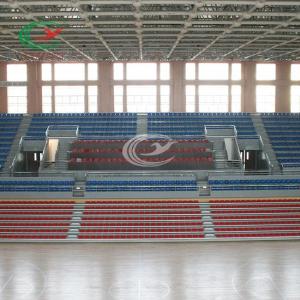

Add to Cart
Stadium Architecture Acoustic Design Basketball Hall Interior
Decoration Design
1. Overview of architectural acoustic design of gymnasium
With the development of sports and cultural undertakings, a large
number of gymnasiums have been or will be built all over the
country. Among these gymnasiums, the vast majority are
comprehensive multi-purpose gymnasiums. In addition to sports
competitions and training, they can also be used for large-scale
theatrical performances, conferences, fashion shows, film
screenings, acrobatics, and circus performances. These gymnasiums
are actually multi-purpose gymnasiums. In order to meet the
multi-functional use requirements of the gymnasium, it must be
professionally designed for acoustics.
The biggest feature of the gymnasium is its large volume, which
causes the reverberation time of the hall to be too long. First of
all, too long reverberation time will reduce the clarity of the
hall's sound quality, make the audience's listening muddy, and
affect the performance and reputation of the performance. For
athletes, they may lose their level due to sound quality problems
in the hall. Secondly, too long reverberation time will also make
the sound reinforcement system howling. In addition, the parallel
walls of the competition pool and the excessively large free sound
path will produce sound quality defects of flutter echo and
multiple echo. It will make the footsteps and impact of athletes
dribbling more intense, and even evolve into a strong noise. The
configuration of contemporary gymnasiums is becoming more and more
diverse, and architectural designers are no longer satisfied with
the previous rectangular design. Circles, ovals, polygons, etc.
emerge in endlessly. And these curved walls and domed ceilings tend
to produce acoustic focus.
2. Architectural Acoustic Design of Gymnasium Sound Quality Design
(1) Defects in sound quality
1. The gymnasium has a large volume, and the free sound path is too
large, which is easy to produce echoes and multiple echoes. Make
people's hearing muddy. Interfere with the normal operation of
audio equipment.
2. Gymnasiums with regular shapes such as rectangles and squares
are prone to flutter echoes. Irregular gymnasiums such as circles
and arcs (most gymnasiums are now irregular in shape) are prone to
sound focusing.
3. When there are various functional rooms such as computer rooms
with serious noise inside the gymnasium, noise will be generated.
Increase background sound. Affect the normal use of the gymnasium.
| Gymnasium Level | The reverberation time of gymnasiums under different volumes according to grades | ||
| >80000m³ | 40000~80000m³ | <40000m³ | |
| Class A | 1.70s | 1.40s | 1.30s |
| Class B | 1.90s | 1.50s | 1.40s |
| Class C | 2.10s | 1.70s | 1.50s |
(2) Solutions
1. According to the function and purpose of the venue, design a
reasonable reverberation time, and install sound-absorbing
materials at the corresponding positions of the competition hall.
2. The competition hall should use rest corridors to isolate
external noise interference, and the rest corridors should be
treated with sound absorption and noise reduction.
3. Noise elimination, noise reduction and vibration reduction
measures are taken for the air supply and return ducts leading to
the competition hall, VIP lounge, sound reinforcement control room,
TV commentary room, sound reinforcement broadcasting room and other
rooms.
4. The air-conditioning room, boiler room and other equipment rooms
should be far away from competition halls, VIP rooms and other
rooms with quiet requirements. When it is adjacent to the main
building, take effective noise reduction and vibration isolation
measures.
3. Material Requirements for Architectural Acoustic Design of
Gymnasium
3.1 Ceiling and wall materials must meet the environmental
protection requirements stipulated by the state.
3.2 Indoor wall decoration and ceilings used for competitions and
training areas should use non-combustible materials. When the site
is equipped with an automatic fire extinguishing system and an
automatic fire alarm system, the interior walls and ceilings can be
decorated with non-combustible materials.
4. Five-step service process
01. Understand customer needs
The first step is to understand the customer's needs (data
provided: on-site video, on-site accurate CAD drawings, the style
that the customer likes)
02. Plane layout planning
The second step is the layout planning, after the modification is
confirmed (charge: deposit for design scheme)
03. Scheme Design Customization
The third step is to customize the scheme design (production of
renderings and simulation software), and confirm the modification
(fee: final payment for design scheme & deposit for
construction design scheme)
04. Construction design drawing
The fourth step is to complete the professional docking of
machinery, equipment, fire protection, water and electricity, etc.,
and complete the drawing of construction drawings (charge: final
payment for construction scheme design & construction deposit)
05. Construction site follow-up
The fifth step is to follow up on the construction site and
actually modify and adjust - the construction is completed.
